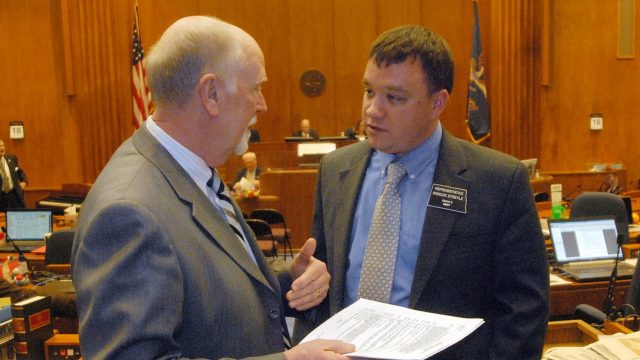Who In Their Right Mind Thought North Dakota Spending Would Remain At Oil Boom Level Highs?

TOM STROMME.Tribune House Majority leader Rep. Al Carlson (R-Fargo), left, and Rep. Roscoe Streyle (R-Minot) both questioned the numbers in state budget revenue projections announced on Wednesday.
There is a lot of concern over North Dakota’s budget picture. And, since we’re in an election year, there are a lot of politically convenient narratives developing around the state’s finances which aren’t necessarily a reflection of the facts.
Concern over the state’s budget is warranted, but a lot of people are talking about falling revenue. The real problem is the spending. And the revenue numbers prove it.
Last week we got the latest general fund revenue report from the Office of Management and Budget (see below), covering the current biennium’s revenues through March.
Below is a graph comparing those revenues to the previous four biennia, and what it shows is that while the current biennium’s revenues are down from the last cycle (which was the peak of the state’s oil boom revenue bonanza) it is still up significantly compared to past biennia.
So far in the 2015-2017 biennium, which began July 1, revenues are down 4.2 percent from the last biennium, but up nearly 16 percent from the 2011-2013 biennium and up more than 78 percent from 2009-2011.

What’s causing a budget crunch is the spending this revenue, which really hasn’t fallen all that far from a historical perspective, supports.
Things could still get worse. Current prognostications call for a tough year for agriculture, and while oil prices have been edging back up again those markets are always volatile. But so far the 2015-2017 biennium is setting the record for the second highest level of general fund revenues in state history.
We’re only seeing it as a down year for revenue because we are coming off what was, historically, the all-time record year for general fund revenues.
You may have read last week that the state’s revenues continue to fall behind even the most recent downgraded revenue forecast. “North Dakota’s lowered expectations for tax revenues proved to be not low enough for the third month in a row in March, leaving the state more than $20 million short of its revised forecast and boosting the likelihood of additional budget cuts or further drawing down reserves,” Mike Nowatzki reported last week.
Accurate, but that’s in need of some context. While missing the revenue forecast by $20 million is not good, it’s worth noting that the forecast is only off by less than 1 percent so far. Here’s the trend line for actual revenues versus the January forecast:

So far, there isn’t much difference.
Here’s the trend line on actual biennium revenues versus the Legislature’s forecast from last year and last biennium’s actual revenues:

The problem is that the state’s revenue forecasters, who produce the numbers lawmakers use to build spending budgets, haven’t been terribly accurate.
Back during the heights of the oil boom they were consistently forecasting revenues that were far too low, missing actual revenue numbers by as much as a billion dollars at times.
Now they keep overestimating revenues, and when actual revenues come in under forecasts some start claiming the state has a “deficit” (there is a battle over that term among the gubernatorial candidates).
The state doesn’t have a deficit problem. The state has a problem getting accurate revenue forecasts.
And, of course, a spending problem. But we always knew cuts were coming, right?
Who in their right mind thought North Dakota’s spending was going to stay at oil boom levels?
[scribd id=310366961 key=key-boGaOfJULp0bfdcAAZ0e mode=scroll]




